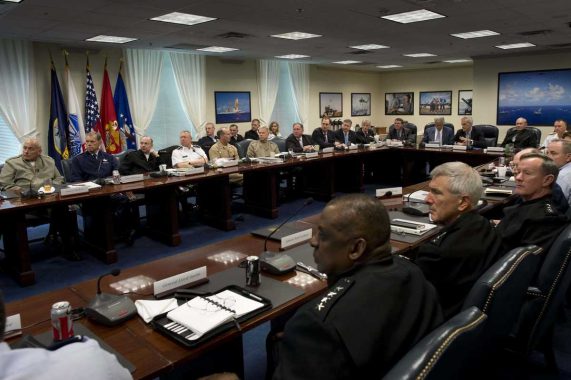Disrupting Acquisition Blog
The Pentagon’s Missing Whiteboards
One day as I sat in a meeting in a Pentagon conference room, it hit me. There are no whiteboards in this room. In fact, most of the conference rooms lack a whiteboard. While individual offices and cubicles have some old whiteboards, they’re lacking in the places where people gather to discuss things.
Most executive conference rooms and meetings have the long polished table with executive chairs around the table and large leather seats along all the walls for those who aspire to sit at the table someday. There are one or two big screens on a wall and a podium for the presenter. The standard meeting is to go through a polished Power Point briefing as it’s displayed on the screen with printed copies in front each executive. Each executive has a binder full of briefings for their day. Prior to this meeting, read aheads were sent out a few days earlier (if you’re lucky) and each exec had a prep meeting with their staffs to get up to speed on the issues so they can come prepared. Some come more prepared than others as you’ll see some execs flip ahead as this is all new information to them.
But this meeting was an action officer level meeting, one of many to discuss how we’re going to tackle a specific initiative. This was the sausage making to try to get something done. As we discussed the issues with representatives from a dozen stakeholder organizations, there was no whiteboard in sight. Nothing for someone to outline the ideas, draw some diagrams of a process, a framework or key issues. No “parking lot” on the side to table a lower priority item for a future meeting. Everyone came with their printed documents and Power Point slides as most of these conference rooms are SCIFs, so no laptops, tablets, or smartphones to access your files or search the web. How arcane.
This is no way to collaborate and innovate. THIS is yet another reason why innovative minds don’t want to come to or stay in the Pentagon.
Imagine if we removed a few chairs and a few framed pictures and artwork and put up a large whiteboard? Imagine if action officers and executives came to meetings having read background materials ahead of time and spent the time brainstorming on the whiteboards and have a more engaged discussion of open issues.

Chris Lynch, former Digital Defense Service director happily innovating with his whiteboard in the Pentagon. Photo credit: Andrew Harrer, Bloomberg
A technique that is gaining momentum in education is the flipped classroom, where students review lectures via videos at home at their own time/pace and spend time in class working on problems. This allows teachers to identify areas where students are struggling, answer questions, discuss key themes to reinforce the reading and videos. Can we apply this model to executive meetings and major program reviews? If everyone read the read-aheads prior to the meeting they can focus only on the open issues.
Jeff Bezos famously banned Power Point presentations at Amazon and instead has attendees spend up to 30 minutes to read a polished six page memo on the topic at hand. As many across DoD are VERY, VERY bad at Power Point, we need a new model. The current approach is to flood our Power Point slides so they can “stand on their own” when emailed around to attendees as read-aheads or after the meeting. The same slides are then used to facilitate discussion with presenters talking to the bullets. Some good leaders will move the discussion along, but many have been trapped in a rehearsed script.
So for the big decision meetings, most of the folks at the table are very familiar with the subject and just need the boss to take a position one way or the other. At these meetings, whiteboards don’t add much value.
Other key meetings focus on key issues/initiatives, process improvement, or various working group discussions. These meetings would benefit tremendously from whiteboards. Capture the issues, ideas, and process steps. Maybe apply some strategies from the Innovation Toolkit to divergent thinking, then converge on a set of solutions.
Ultimately, we need more innovators across the Pentagon with large whiteboards, boxes full of Expo markers, and piles of Post-It notes actively tacking DoD’s toughest challenges.
Disclaimer: The opinions expressed here are those of the authors only and do not represent the positions of the MITRE Corporation or its sponsors.
Subscribe to Our Newsletter



0 Comments